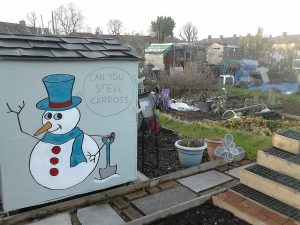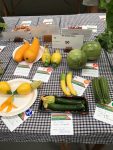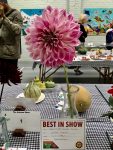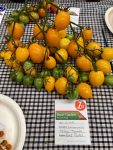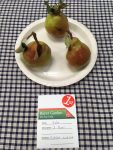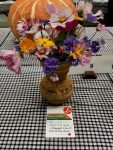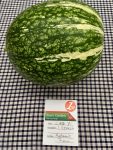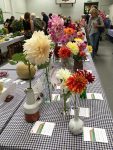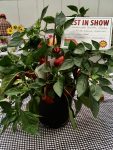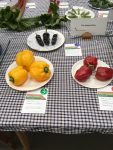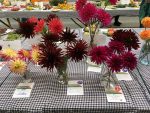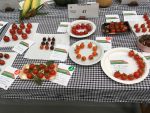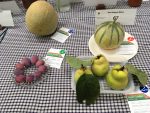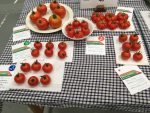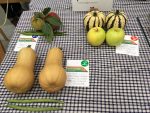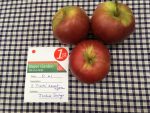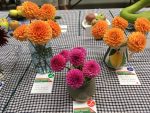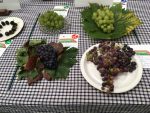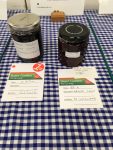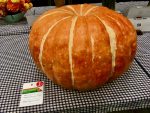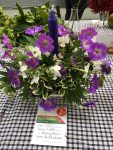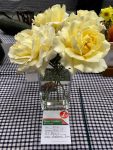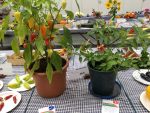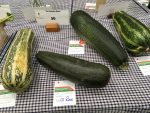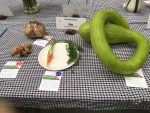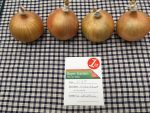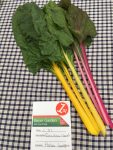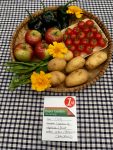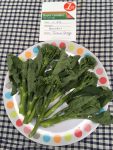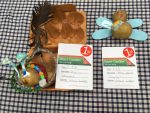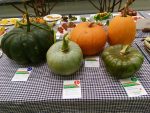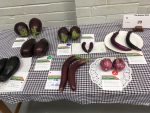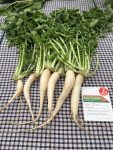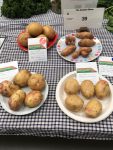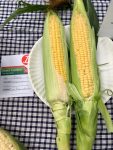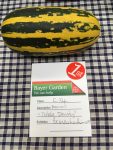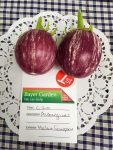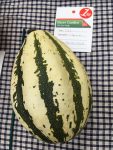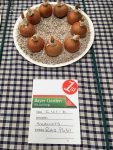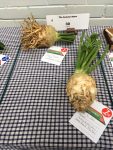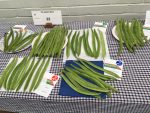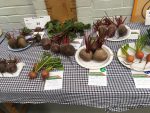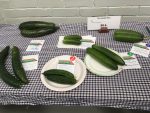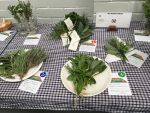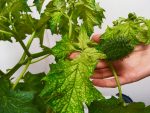December jobs on your allotment
Maintaining soil and structures and planning ahead
- Clear away any remaining plant debris from plots and compost if disease-free.
- Earth up and check stakes on Brussels sprouts and other tall brassicas to prevent wind rock.
Sowing and planting
- Protect autumn-sown broad beans with cloches during extended periods of frost.
- Divide and replant rhubarb. For early tender stems, ‘force’ rhubarb by covering crowns with a dark-coloured bucket or terracotta rhubarb forcer.
- Ventilate green houses on mild days to reduce diseases.
- Continue to plant fruit trees and bushes if soil is not frozen.
- Plant blackcurrants 5cm below the soil to encourage new shoots.
- Plant fruit trees trained as cordons or espaliers to make good use of limited space. Check RGS website for guidance on permitted trees.
- Plant blueberries in pots of ericaceous compost.
Pruning
- Prune grape vines before the end of the month, when dormant, to avoid sap bleeding.
Harvesting
- Continue to harvest Brussels sprouts, kale and winter cabbage.
Gardening for wildlife
- Feed birds regularly. Disinfect bird tables and water dishes regularly to avoid spreading disease.
Committee Minutes October 2018
AGM Minutes 2018
Download and read the minutes from the 2018 AGM here:
November jobs on your allotment
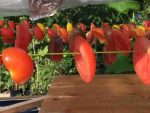
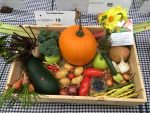
Maintaining soil and structures and planning ahead
- Continue to clear all plant debris from plots. Do not add blighted tomatoes to your compost, but burn or take to the dump.
Empty compost heaps and use the well-rotted dark crumbly material. - Apply a 5cm layer of well rotted compost or manure to bare plots or cover bare areas with brown cardboard weighed down with damp grass clippings.
- Prepare a winter compost trench for next season’s moisture loving plants such as sweet peas, runner beans or squashes. Dig a trench a spade deep and fill with kitchen vegetable waste covering each additional layer with soil.
Sowing and planting
- Continue to sow overwintering broad beans.
- Sow hardy peas either straight into the ground under fleece or 3 to a 9”pot to be planted out when the roots reach the bottom.
- Sow a gutter of peas in the green house or under cloches for salad or risotto at Christmas time.
- Sow cut-and-come-again salads in a sheltered spot or green house.
- Finish planting onion sets and garlic.Garlic needs a chilling period so plant now. With current wet winters plant on a ridge to aid drainage.
- Sow dill, chives and parsley now on a sunny windowsill.
- Order bare root trees now for the best selection.
- Fix grease bands to fruit trees to protect against winter moth. To help control pests and diseases spray fruit trees with winter wash on a calm, dry day.
- Once leaves have dropped and before bud break in February spray fruit trees with winter wash on a calm, dry day. Spraying helps to reduce overwintering pests.
- Start winter pruning of apples and pears.
- Keep overwintering brassicas covered with netting to prevent pigeon damage.
- Stake tall brassicas against wind damage.
- Sow green manures early in the month such as grazing rye.
- Clean the greenhouse to maximise light levels and before the water is turned off in December.
Harvesting
- Start to harvest winter cabbage, Brussels sprouts, leeks and kale. Wait until after frosts for parsnips as they will be sweeter.
Pruning
- Begin winter pruning of apples, pears and vines.
- Prune overgrown blackcurrant bushes- remove a third of the oldest stems to ground level.
- Fruited canes of blackberries and hybrid berries such as tayberries and loganberries should be pruned to ground level.
Gardening for wildlife
- Remove surplus dead leaves from ponds to prevent decomposition pollution.
- Clean out bird boxes of old nesting material so they may be used as winter roosts.
November 2018 Bulletin
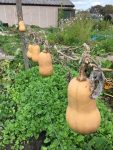
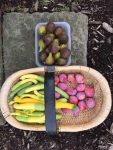 Download and read our November 2018 Bulletin
Download and read our November 2018 Bulletin
Lovely autumn produce
Plot jobs for November
and, after a most successful AGM:
- a report from our newly elected Chair, Helen Finch
- who’s who on the committee
- who won this year’s awards
Committee Minutes September 2018
October jobs on your allotment
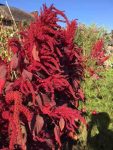
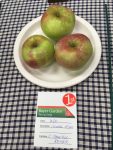
Maintaining soil and structures and planning ahead
- Continue to clear the ground of this summer’s growth, weeding as you go.
- Turn the compost heap to speed its decomposition.
- Compost fallen leaves in hessian bags. Compost pea and bean foliage,but leave the roots in the ground as they contain nitrogen.
- Plan where you will grow brassicas next year. Manure the area now and lime in the spring if the ph level is below 7.
- To maximise light levels and reduce harbouring of bugs, clean the green house with eco-friendly detergent. Garden disinfectant such as Jeyes Fluid can be used in a greenhouse or a sulphur candle if resident bugs are suspected.
- Make a last cut on grass paths and reinstate beds where grass has encroached.
- Apply grease bands around the trunks of fruit trees as a barrier to winter moths.
- Order bare-rooted fruit trees to be delivered November onwards. (See guidance on website and contact Site Secretary)
- Check that the bird netting on brassicas is secure in preparation for more wintry weather.
- Collect seeds of plants that have not been harvested. Peas and beans save well. Collect directly from the plant on a dry day to avoid fungal rot and put straight into paper bags.
Sowing and planting
- Winter salads and oriental greens can be sown in the green house or cold frame.
- Sow over-wintering broad beans either directly or start under cover in pots or root-trainers.
- Sow green manures such as rye, vetches or ryegrass to be dug in next February.
- Plant overwintering onion sets and garlic. Soil must be well drained. Onion sets should just peep above the surface. If the ph is lower than 7 add a little calicified seaweed. Plant garlic planted 1.5- 2”deep, spaced 7” apart. Both benefit from onion fertilizer.
- Plant daffodils, alliums and other spring bulbs for early spring flowering. (Hold off planting tulips till November.)
- Sow sweet peas in a cold frame or unheated greenhouse for early summer flowering and showing. Sow in root trainers or 3” pots.
- Plant out spring cabbage 6” apart.
- Take hardwood cuttings, 1ft long, from gooseberries and currants. Plant in pots of compost.
Harvesting
- Harvest winter squashes. Cut the squash carefully leaving a 2-3” stem. ‘Cure’ in a warm, dry place for 10-14 days, then in a cool, light place at around 50-55F until ready to eat. Many squash can be stored for up to 6 months.
- Store disease-free apples, pears and potatoes in a cool, dry place.
- Ensure carrots are protected with insect mesh as carrot flies are most damaging in late summer and autumn. Leave in the ground to harvest as needed.
- Harvest maincrop potatoes. Check each tuber for disease or damage and do not store damaged tubers. Store in a cool, dry place. Let the tubers dry off before storing in jute, hessian or paper bags in a dark frost-free place.
Pruning
- Lift and divide rhubarb plants that have been in situ for more than 5 years or are less productive. Keep and replant the newer outside growth and discard the centre.
- Cut down asparagus stems as they turn yellow and mulch with well-rotted manure.
- Clear away strawberry foliage to prevent build-up of pests and diseases.
Gardening for wildlife
- Leave decorative perennial seed heads as food and habitats for wildlife
- Build an insect hotel or install a log pile.
Autumn Show Results and Picture Gallery 2018
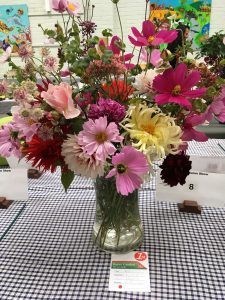
Read the list of 2018 Autumn Show First Prize Winners
Click on the gallery to view the show:-
This gallery contains 61 photos
October 2018 Bulletin
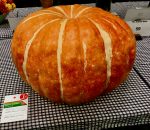 Download and read our October 2018 Bulletin
Download and read our October 2018 Bulletin
- How big can a pumpkin get? – a full report from our popular Autumn Show
- Time for planting again – garlic and onion sets in store now
- Do you have apples to spare? – find out about the orchard project
- Latest update from Putney Community gardeners
and what was that mystery plant?…….
September 2018 Bulletin

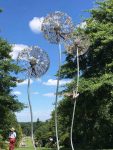 Download and read our September 2018 Bulletin
Download and read our September 2018 Bulletin
- Annual visit to Wisley
- Rhubarb cake and tomato tart
- Encourage those predators and beneficial insects
- Anything out there for the Autumn show?
…and, thinking ahead, the store will soon have tulips, narcissi and allium bulbs for planting. Still time to sow some seeds – try rocket, kale and more…
September jobs on your allotment
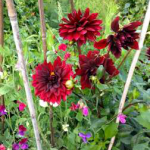
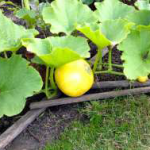
Maintaining soil and structures and planning ahead
- Deep-dig out perennial weeds such as invasive bindweed and couch grass. Keep weeding to prevent weeds seeding.
- Begin to add well rotted manure to bare areas.
- Empty the compost bin by bagging up compost from the bottom of the bin or heap. Store it ready for use next spring and start a new mix.
- Cut bean and pea plants away at ground level when they have finished cropping. Leave the roots to slowly release nitrogen back into the soil.
- Empty the compost bin by bagging up compost from the bottom of the bin or heap and store ready for use next spring.
- In the greenhouse, rake off the top centimetre of soil to clear out any pests near the surface and replace with grit. Next spring remove the grit and replace with clean potting compost.
Sowing and growing
- Spinach, coriander, rocket and parsley can all be sown until the middle of the month.
- Sow fast-growing Oriental greens such as pak choi and mizuna.
- Sow winter greens such as land cress, corn salad and hardy lettuce cultivars (including ‘Arctic King’ and ‘Valdor’) for spring picking. Sow kale for early spring harvesting and rocket for autumn harvesting.
- Sow hardy annuals such as calendula officianalis in shallow drills for late spring flowering next year.
- Sow green manures in vegetable beds that are to be left fallow for the winter. When dug in they conserve nutrients and improve soil texture.
- Sow broad bean varieties such as Aquadulce, de Monica or Masterpiece Green Longpod in late September for harvesting in late May, early June.
- Pot up strawberry runners to make new plants for next summer or plant out new strawberries.
- Plant out spring cabbage.
- Plant overwintering onion sets.
- Plant daffodil bulbs for early spring flowering.
- Start planting trees at the end of the month while the soil is still warm.
- Harvest maincrop potatoes. Check each tuber for disease or damage and do not store damaged tubers. Store in a cool, dry place. Let the tubers dry off before storing in jute, hessian or paper bags in a dark frost-free place.
- Protect leafy vegetable crops with bird netting.
- Cut out the fruited canes of summer raspberries, blackberries, loganberries and tayberries. Leave the new green canes as these will crop next year. Prune blackcurrants. After picking autumn-fruiting raspberries, do not prune. Wait until late winter/ early spring to cut all the canes down to ground level.
- Continue to feed and water tomatoes. Pinch out the tips of cordon tomatoes to concentrate the plants energy into fruiting. Cropping can continue well into the autumn.
- In the greenhouse sow herbs, salad leaves such as pea shoots, beetroot and chard for winter leaves.
- Apply grease bands to fruit trees at the end of the month to deter winter moth.
- Keep leeks protected with insect mesh against leek mining fly and leek moth.
- Do not compost blight-affected foliage or tubers of potatoes and tomato plants or rose leaves affected with black spot.
Harvesting
- Store onions that have been dried in nets in well-ventilated conditions.
- Continue to harvest sweetcorn.
- Cut herbs for drying and use throughout the winter.
- Continue picking autumn raspberries and blackberries.
- Ensure carrots are protected with insect mesh as carrot flies are most damaging in late summer and autumn.
- Water plants in the morning to help prevent fungal diseases.
- Continue harvesting apples and pears. Store in a cool, well-ventilated place. Black, scabby blotches, distortion and cracking on apples and pears indicates scab disease. Affected fruit will not store well but can be eaten now.
- Leave autumn squashes to ripen on the plant as long as possible and remove the leaves to maximise sunlight. Place fruit on a wooden board or tile to prevent soiling. Fruits are ready when richly coloured and ring hollow when tapped.
Gardening for wildlife
- While tidying up the plot, be sure to leave some seeded flower heads to provide winter food for birds. Leave some areas of dead vegetation for insect life over winter.
- Birds now start to look for food for the winter months so keep bird feeders topped up.
- In ponds, thin out oxygenating and floating plants. Leave debris at the side of the pond overnight so creatures can return to the water. If the pond is near deciduous trees, scoop out the leaves before they sink to the bottom.
Check what produce you may have to enter in the Autumn Show or donate to the produce stall.

